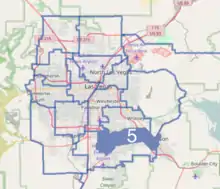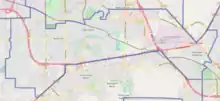Nevada's 5th Senate district
Nevada's 5th Senate district is one of 21 districts in the Nevada Senate. It has been represented by Republican Carrie Buck since 2020, succeeding Democrat Joyce Woodhouse.[3]


| Nevada's 5th State Senate district | |||
|---|---|---|---|
.png.webp) | |||
| Senator |
| ||
| Registration | 41.6% Democratic 35.6% Republican 17.2% No party preference | ||
| Demographics | 60% White 6% Black 20% Hispanic 9% Asian 5% Other | ||
| Population (2018) | 135,233[1][2] | ||
| Registered voters | 73,612 | ||
Geography and demographics
District 5 covers parts of Henderson and Paradise to the south of Las Vegas in Clark County.[3]
The district is located entirely within Nevada's 3rd congressional district, and overlaps with the 21st and 29th districts of the Nevada Assembly.[4] The district has a surface area of 26.2 square miles (68 km2), and a perimeter of 34.3 miles (55.2 km).[5]
According to the 2010 census, the district had a population of 128,800 – 0.16% above the ideal. The district has a relatively high proportion of white and Asian American residents compared to the Nevada average.[2] The district's population is better-educated than the Nevada average: more than 35% of the district's inhabitants have an associate's, bachelor's, or graduate degree. The median household income, a little over $62,000, is nearly $10,000 above the Nevada median, and the poverty rate is 8.5%, close to twice as low as in the rest of Nevada.[6]
Recent election results
Nevada Senators are elected to staggered four-year terms; since 2012 redistricting, the 5th district has held elections in presidential years.
2020
| Party | Candidate | Votes | % | |
|---|---|---|---|---|
| Republican | Carrie Buck | 32,740 | 48.8 | |
| Democratic | Kristee Watson | 32,411 | 48.3 | |
| Libertarian | Tim Hagan | 2,007 | 3.0 | |
| Total votes | 67,158 | 100 | ||
| Republican gain from Democratic | ||||
2016
In the 2016 Democratic primary, incumbent Joyce Woodhouse faced Nicholas Lash, a political newcomer who claimed senator and presidential candidate Bernie Sanders as his inspiration. Lash said he wouldn't accept any campaign donations, as he wanted "to prove Bernie's point about taking the money out of politics." He called Woodhouse an "establishment candidate," and said he would, if elected, press for the establishment of a single-payer health care system and education reforms. Woodhouse, meanwhile, said she was "really proud" of the progress the legislature had made on education funding, and promised to focus on education and child care regulations if elected to another term.[8] Woodhouse defeated Lash with over 80% of the vote.[9]
Woodhouse faced Republican Carrie Buck and Libertarian Tim Hagan in the general election. Woodhouse maintained her focus on education, while Buck, a charter school director, attacked Woodhouse's education record and called her part of the "status quo." Hagan, meanwhile, said he wanted to "give voters another choice," and said he would push for a tax reduction and for the expansion of school choice.[8] Woodhouse out-raised Buck $500,000 to $140,000, and defeated her by less than one percentage point.[10][11]
| Primary election | ||||
|---|---|---|---|---|
| Party | Candidate | Votes | % | |
| Democratic | Joyce Woodhouse (incumbent) | 4,145 | 85.5 | |
| Democratic | Nicholas Lash | 704 | 14.5 | |
| Total votes | 4,849 | 100 | ||
| General election | ||||
| Democratic | Joyce Woodhouse (incumbent) | 26,208 | 47.9 | |
| Republican | Carrie Buck | 25,739 | 47.0 | |
| Libertarian | Tim Hagan | 2,784 | 5.1 | |
| Total votes | 54,731 | 100 | ||
| Democratic hold | ||||
2012
In 2012, Democratic former state senator Joyce Woodhouse faced Republican Steve Kirk, who had previously defeated Annette Teijeiro in the Republican primary.[12] Kirk, a 12-year Henderson City Councilman, supported Governor Brian Sandoval's tax increase in order to preserve the education budget, while Teijeiro insisted on decreasing taxes.[13] With the endorsement of the Senate Republican Caucus, Kirk won the primary with over 70% of the vote.[14]
Woodhouse, who had previously lost re-election to the state senate in 2010, argued that the state needed legislators "who are looking out for middle-class working families," and emphasized the economy and education. Kirk, meanwhile, argued that the state government needed more private-sector experience. Both candidates said they considered themselves moderates, although Kirk also called himself "very conservative fiscally."[15] Woodhouse ultimately won the election by around four points.[16]
| Primary election | ||||
|---|---|---|---|---|
| Party | Candidate | Votes | % | |
| Republican | Steve Kirk | 3,090 | 71.2 | |
| Republican | Annette Teijeiro | 1,247 | 28.8 | |
| Total votes | 4,337 | 100 | ||
| General election | ||||
| Democratic | Joyce Woodhouse | 26,520 | 52.0 | |
| Republican | Steve Kirk | 24,524 | 48.0 | |
| Total votes | 51,044 | 100 | ||
| Democratic hold | ||||
History
District 5 came into existence in 2012 after the senate districts were redistricted as a result of the 2010 Census.[18] The new districts went into effect for filing for office, and for nominating and electing senators on January 1, 2012, and for all other purposes on November 7 – the day after Election Day, when the new senator terms began. In the Nevada Revised Statutes, the area of the 5th district is defined using census tracts, block groups, and blocks.[19]
It was originally known as Clark County Senate District 5 and was a dual member district. In the 1980s, it stretched from Sandy Valley toward Spring Valley, Enterprise and southern Paradise. In the 1990s, it contracted in size and stretched from northwest Las Vegas into Henderson. In the 2000s, it became based around most of Henderson.
Previous holders of the seat included Bill O'Donnell, Ann O'Connell, Sandra Tiffany, Joe Heck, Shirley Breeden and Michael Roberson.
References
- "State Senate District 5, NV". Census Reporter. Retrieved March 28, 2020.
- "Nevada State Senate - 2011 Districts: State of Nevada Population Report" (PDF). Nevada Legislature. Retrieved March 28, 2020.
- "Legislator Information: Senator Carrie A. Buck". Nevada Legislature. Retrieved November 29, 2020.
- David Jarman. "How do counties, House districts, and legislative districts all overlap?". Daily Kos. Retrieved March 28, 2020.
- "Nevada State Senate - 2011 Districts: State of Nevada Area Analysis Report" (PDF). Nevada Legislature. Retrieved December 17, 2016.
- Research Division of the Legislative Counsel Bureau (May 2015). "Demographic Profile of Nevada Senate District No. 5 of the 78th Session (2015)" (PDF). Nevada Legislature. Retrieved December 17, 2016.
- "Nevada State Senate District 5". Ballotpedia. Retrieved November 29, 2020.
- Brean, Henry (October 25, 2016). "State Senate District 5". Las Vegas Review-Journal. Retrieved December 23, 2016.
- "State Senate". Nevada Secretary of State. August 3, 2016. Retrieved December 19, 2016.
- Chereb, Sandra (November 5, 2016). "Reports show fundraising edge for some Nevada legislative candidates". Las Vegas Review-Journal. Retrieved December 23, 2016.
- "Nevada State Senate". Silver State Election. November 22, 2016. Retrieved December 19, 2016.
- Vogel, Ed (May 27, 2012). "2012 PRIMARY ELECTION: STATE SENATE DISTRICT 5". Las Vegas Review-Journal. Retrieved December 23, 2016.
- Vogel, Ed (January 26, 2012). "Henderson doctor pursues state Senate seat". Las Vegas Review-Journal. Retrieved December 23, 2016.
- "State Senate". Nevada Secretary of State. Retrieved December 19, 2016.
- Vogel, Ed (October 21, 2012). "2012 Voter Guide: Nevada Senate District 5". Las Vegas Review-Journal. Retrieved December 23, 2016.
- "Nevada State Senate". Nevada Secretary of State. November 27, 2012. Retrieved December 19, 2016.
- "Daily Kos Elections Statewide Results by LD". Daily Kos. Retrieved June 30, 2020.
- "Final District Plans: Congressional, Legislative, and Board of Regents". Nevada Legislature. June 7, 2012. Retrieved December 17, 2016.
- "CHAPTER 218B - LEGISLATIVE DISTRICTS". Nevada Legislature. Retrieved December 17, 2016.